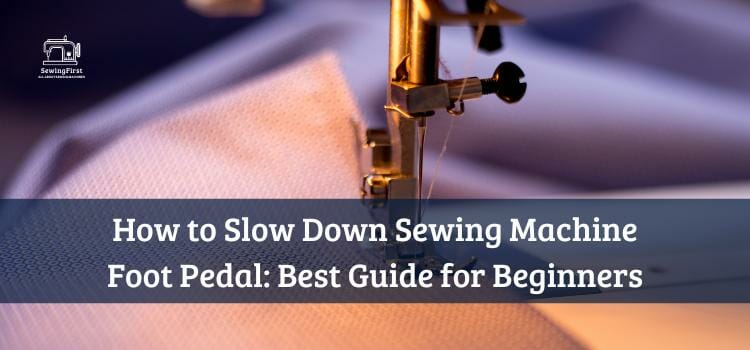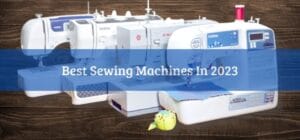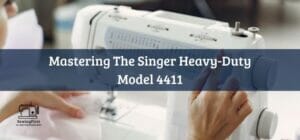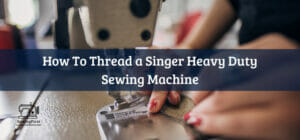Are you having trouble keeping up with the speed of your sewing machine? Have you ever wished that there was a way to slow down your foot pedal? If so, then this article is for you! Here we’ll discuss how to safely and easily adjust your sewing machine’s foot pedal speed.
By following certain steps, such as checking the manual or consulting an expert on the matter, it’s possible to achieve greater control over your machine. This can help ensure safety when working on projects that require precision and accuracy – something many sewers strive for!
Additionally, adjusting the foot pedal can also reduce fatigue caused by repeatedly pressing the pedal at high speeds throughout extended periods of time.
In this article, readers will learn how to slow down sewing machine foot pedals in order to create more accurate results while reducing strain. Keep reading if this is something you’re interested in achieving!
Related Topic: Are Sewing Machine Foot Pedals Interchangeable? Tips and Tricks!
Table of Contents
ToggleWhat Makes Sewing Machine Foot Control Too Fast?
Let’s go back in time and start from the beginning. What makes sewing machine foot control too fast? Different machines have different speed settings, but if you’re trying to find your way around a pedal that seems like it wants to take off faster than Usain Bolt, then you need to look at the speed controller.
It can be adjusted by either turning a dial or manipulating buttons on the side of the device. This will change how much power is sent through to the motor that drives the needle – meaning you’ll be able to get it down to its lowest speed setting.
If none of these options are available on your machine, there may be an issue with the wiring. Try replacing it with another foot pedal designed for your model and make sure it has adjustable speeds (keyword: speed controller).
That should give you more control over the rate at which your work gets done; plus, safety should never come second when operating machinery! With a new foot pedal installed correctly, you’ll soon be stitching away happily at whatever pace suits you best.
Are Sewing Machine Foot Pedals Interchangeable?
Are sewing machine foot pedals interchangeable? The answer is yes. Sewing machines come with a variety of different types of foot controls, and these can be swapped out for one another to fit the user’s needs. However, when changing out the pedal it’s important that you ensure your new pedal has adjustable speed settings in order to control both the needle and foot speed accordingly.
Here are 5 things to consider when looking for an interchangeable foot pedal:
- Make sure it fits with your brand and model of sewing machine
- Look for an option with variable speeds so you can adjust as needed
- Choose a durable material that will resist wear over time
- Consider how much strain the design puts on your feet while working
- Ensure safety features such as a non-slip grip or rubberized base It is also wise to test out any potential replacement before committing to purchase, if possible.
This way, you can make sure it satisfies all of your requirements and runs smoothly. Making sure that you have the right setup is key to producing quality results from your project!
Changing out old pedals for newer models is a great step towards achieving desired levels of precision and accuracy in sewing projects. With the right selection process and due diligence, users should have no problem finding just what they need among available options.
How To Slow Down Sewing Machine Foot Pedal?
Controlling the speed of a sewing machine’s foot pedal is important for creating quality fabric projects. It can be difficult to precisely control the speed and intensity of a foot pedal, but there are some helpful tips that you can use to make sure your project comes out correctly.
To slow down a sewing machine’s foot pedal, start by adjusting any available settings on the sewing machine itself. Many machines come equipped with adjustable speeds that allow users to set their desired slower speed or slowest speed.
You should also look at the manual accompanying your specific model to see if it offers additional ways of controlling the speed. In addition, here are some tips and suggestions for controlling speed:
- Experiment with using different amounts of pressure on the foot pedal; this will help you get used to how much pressure needs to be applied in order to achieve the right slower speed.
- Take breaks during long projects so that your feet don’t tire quickly while pressing down on the foot pedal.
- Place something heavy (like a book) over the foot pedal when not in use; this will prevent it from moving unexpectedly which could cause an accident or injury.
- Make sure all parts of your sewing machine are functioning properly before starting as they may affect how well your foot pedal works.
These methods can help you reduce accidents and improve accuracy while working with fabrics, ensuring you have safe and successful results every time!
Some Tips And Suggestions For Controlling Speed
Are you the kind of person who can’t seem to just sit and enjoy a movie without the remote in your hand? Do you love having complete control over everything, even when it comes to sewing projects?
If so, then I’ve got some good news for you. You don’t have to rely on fate or luck when controlling sewing speed with a foot pedal – there are plenty of options available!
- If your machine has an adjustable speed controller like a dial or a screw, use that to find the perfect balance between slow and fast stitching.
- Look for a speed adjustment screw near the needle plate – this will give you a much more precise stitch selection than any other option.
- Many modern machines come equipped with a speed slider right next to the foot pedal; adjust this one until you get exactly what you need.
No matter which method you choose, keep in mind that too-fast (or too-slow) speeds can ruin projects quickly – so take your time and make sure all settings are just right before starting out on that next big project!
How Does A Sewing Machine Foot Pedal Work?
A sewing machine foot pedal is a unique device that helps you control the speed of your sewing machine. It has two main components: The pedal and the speed control slider.
The speed control slider allows you to adjust how quickly or slowly your needle moves, while the foot pedal gives you direct control over the motor’s power. This makes it easy to sew with precision and accuracy.
Here are 3 benefits of using a sewing machine foot pedal:
- You can precisely regulate the speed of your stitching – from slow and careful stitches when working on delicate fabrics, to faster speeds when dealing with thicker fabrics.
- A foot pedal adds an extra level of safety by giving you full control over where and when your fabric needs to be moved in order for optimal results.
- It also allows you to have more accurate seams because it provides greater pressure when pressing down on the cloth during stitching.
By having complete mastery over your project’s speed, size, shape, and movement, you can create beautiful pieces with ease and comfortability knowing that each stitch will come out just as intended. Now let’s take a look at Bernina’s foot pedal problems!
Identifying The Root Cause Of Foot Pedal Running Too Fast
If your sewing machine’s foot pedal is running too fast, it can be frustrating. Identifying the root cause of this issue requires a bit of detective work and understanding how the speed control lever works on the sewing machine pedals.
The first thing to do is check if there are any visible signs that the speed control lever has been moved or tampered with. If not, then you should inspect the connection between the foot pedal and the machine motor speed control.
It could be that something has caused an increase in electrical current, which would make for faster operation than normal. Another possibility is that internal wiring within the machine itself has become loose or disconnected from its original configuration.
In order to ensure safety while repairing a sewing machine foot pedal, it is important to identify what specific part needs attention and take necessary precautions before attempting any repairs or adjustments.
By taking some time to diagnose the actual problem and then address it accordingly, we can restore our machines back to their usual smooth sailing performance!
How To Repair A Sewing Machine Foot Pedal
Have you ever had your sewing machine foot pedal running too fast? It can be a real nuisance when it’s difficult to slow down the speed. How can we fix this issue and get back to our projects?
The root cause of this problem is likely an issue with the motor speed or auto speed controller. To repair this, try replacing the parts that are causing the constant rapid-fire speed.
This process will require knowledge about how to replace these specific components in your sewing machine. If you’re not confident doing so yourself, look into having it serviced by a qualified technician who specializes in repairing sewing machines.
Once you’ve replaced those components, there are still adjustments needed for optimal performance, such as calibrating the right tension balance and making sure your foot pedal fits firmly on its base plate. With careful tuning, you’ll be able to control the power output from your machine more effectively and safely.
Sewing Machine Foot Control Adjustments
When it comes to sewing, the foot pedal is a critical component. Most modern sewing machines come with adjustable speed control features and if you find your machine’s pedals too sensitive or not sensitive enough, then you may need to make some adjustments.
There are three main aspects of adjusting any model’s foot control: speed range, minimum speed, and maximum speed. Adjusting these settings can be tricky depending on the type of sewing machine you have but here are a few tips:
- If possible, consult the manual that came with your specific model as each one has its own unique requirements.
- Don’t forget to unplug your machine before making any changes!
- Make small adjustments at first; this way you can gauge what works best for your particular project without having to start from scratch again.
Tailoring the foot control settings of your sewing machine can help improve comfort and accuracy when working on projects. It takes time and practice to get used to different models but once you dial in the perfect combination of the speed range, minimum speed, and maximum speed – working on projects becomes much more enjoyable! With careful adjustment, even complex projects become easier than ever before.
Sewing Machine Runs Without Pressing Pedal
Have you ever had a sewing machine run without pressing the foot pedal? This is an issue that can be caused by electrical connections. To fix this, it’s important to check whether the machine is running at its normal speed or faster when not operated with the foot pedal.
If your machine is working too quickly on its own, then there may be some loose wiring or other electrical connection problem. Check all of the wires connected to and from the foot pedal and make sure they are properly connected, secured tightly, and free of any wear and tear.
If everything looks good, try adjusting how much pressure has to be applied to the foot pedal for it to work correctly – sometimes this can cause issues if set too low. With these steps followed carefully, you should have your sewing machine back up and running smoothly!
How To Test A Sewing Machine Foot Pedal
Knowing the condition of your sewing speed is critical for achieving results that will make you proud. Testing the foot pedal can help ensure that your computerized sewing machine is running at its best performance.
In order to understand how well your conceptual motor speed controller is functioning, it’s important to first check the electrical connections and wiring on the foot pedal itself. If everything looks good there, then plug in the power cord and press down on the pedal – if it responds with no jerky movements or noises then you should be good to go!
It’s wise to also consider testing different speeds by gradually pressing down on the pedal and seeing how quickly or slowly it moves. This can give you an indication of what kind of work you’ll be able to do with this particular piece of equipment. With all these tests complete, you’ll have peace of mind knowing your sewing machine is ready for use!
How To Open A Sewing Machine Foot Pedal
Adjusting the speed of a sewing machine foot pedal can be intimidating, but with the right steps, it’s easy. To start, open up your sewing machine and locate the foot pedal.
It should look like a small black box or have exposed wires; either way, you’ll need to access the inside of the box to adjust its speed control. Once you’ve opened up the panel, use a screwdriver and unscrew any screws that may be holding in place parts of your foot pedal.
Carefully remove each component until you find the actual regulator for controlling the speed of your sewing machine. Adjust this regulator as needed to create a comfortable speed for extended periods. Remember that setting too high a speed could damage both your materials and machine over time!
Troubleshooting Sewing Machine Foot Pedal Problems
Taming a runaway sewing machine foot pedal can be like trying to catch the wind – difficult and unpredictable, yet necessary. Every seamstress knows that having a consistent speed is key for precision and accuracy when creating any project; so let’s take a look at how we troubleshoot these kinds of issues with our beloved machines.
First off, checking your maximum sewing speed setting is paramount in order to identify if this might be what is causing the issue. Industrial machines tend to have multiple settings on their foot pedals which can affect the speed dramatically; ensuring you are at the correct level should be done prior to any further maintenance or repairs.
Additionally, if it seems as though the pedal has become unresponsive then there may be some dirt or dust blocking electrical signals from being sent properly. This can easily be fixed by cleaning out all of the components thoroughly with an air compressor or brush vacuum cleaner attachment tool.
Lastly, older machines often require lubrication after extended use; adding oil around specific parts will help keep your pedal working effectively over time.
With proper care and maintenance, you’ll soon find yourself able to control even the most stubborn sewing machine foot pedals!
Preventing Future Sewing Machine Foot Pedal Issues
You’ve probably heard of the saying: “An ounce of prevention is worth a pound of cure”. That’s certainly true when it comes to sewing machine foot pedal problems! You can’t always trust modern sewing machines, especially if they’re not functioning properly.
But there are ways to prevent future issues from cropping up. For example,
- You should use an extremely slow speed on your machine whenever possible; this will help avoid any hiccups in its performance.
- Make sure that all electrical connections are secure and tight so that no wires become loose or disconnected during operation.
- Regularly check for signs of wear and tear on the foot pedal itself — such as fraying cords or cracks — and replace them immediately if need be.
By taking these steps now, you’ll save yourself time (not to mention money!) later by avoiding costly repairs down the road. Who knows? Maybe with proper care and maintenance, you won’t have to worry about troubleshooting ever again!
Conclusion
In conclusion, sewing machine foot pedals can be an excellent tool for speeding up your projects. However, if it gets too fast and out of control, you have to take the time to slow it down. Fortunately, this isn’t as difficult as it may seem. With some simple adjustments and troubleshooting techniques, you can get back in control.
As they say, “slow and steady wins the race”; taking your time to adjust the speed of your sewing machine’s foot pedal is an essential step in ensuring successful results every time. So don’t rush through these steps – treat them like gold nuggets along the path to success!
FAQs
Is there a way to adjust speed on a sewing pedal?
Yes, some sewing machine pedals have an adjustable speed control. It will usually have a dial that can be turned to adjust the speed of the machine. If your pedal does not have an adjustable speed control, you may be able to purchase an aftermarket speed control for your machine.
How do I lower the speed of my sewing machine?
Most sewing machines have a speed dial or knob that can easily be adjusted to control the speed of the machine. Depending on the machine, the dial or knob may be located on the side or front of the machine. If the dial or knob is not present, then you may need to refer to your machine’s manual for specific instructions.
How do you slow down the foot pedal on a Brother sewing machine?
Most Brother sewing machines have an adjustable foot pedal. To slow down the speed of the foot pedal, turn the speed control knob located on the side of the machine to the left. The left side of the speed controller knob will decrease the speed of the foot pedal.
How do I change the speed on my Singer sewing machine?
The speed of your Singer sewing machine is determined by the pressure applied to the foot pedal. To increase the speed, press the foot pedal more firmly, and to decrease the speed, press the foot pedal more lightly.
How do you adjust the foot pressure on a sewing machine?
The foot pressure can typically be adjusted on a sewing machine by using a screw or knob located on the back or side of the machine. Refer to the machine’s manual for specific instructions.
How do you slow down the speed of an industrial sewing machine?
The speed of an industrial sewing machine can be slowed down by adjusting the clutch knob or wheel. This is usually located on the side of the machine. Turning the wheel clockwise will slow the speed of the machine while turning it counterclockwise will increase the speed.





